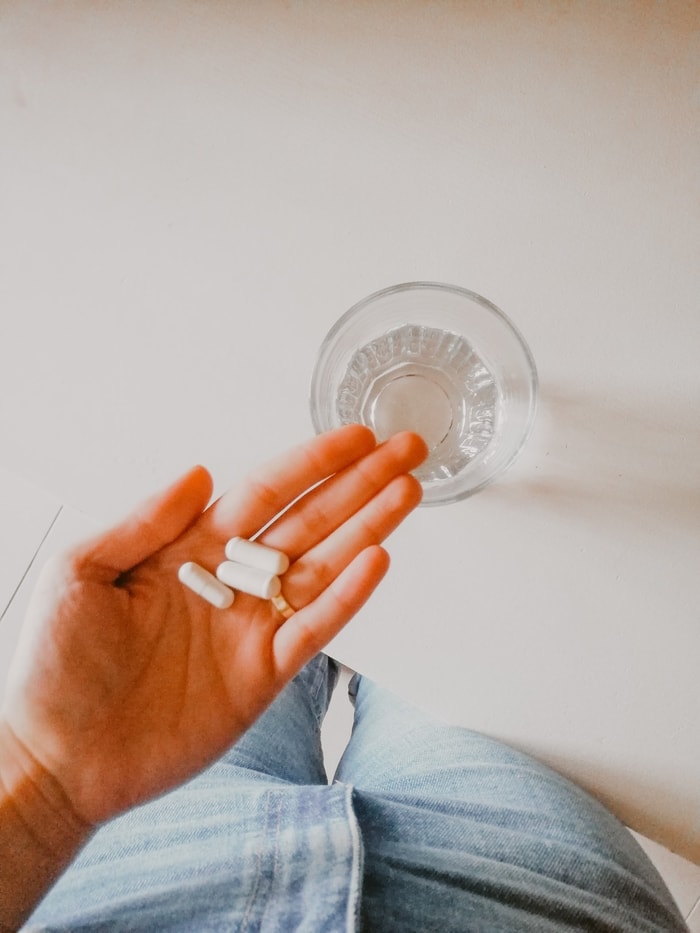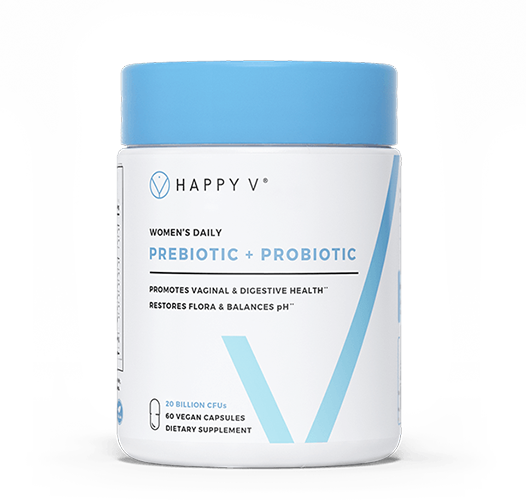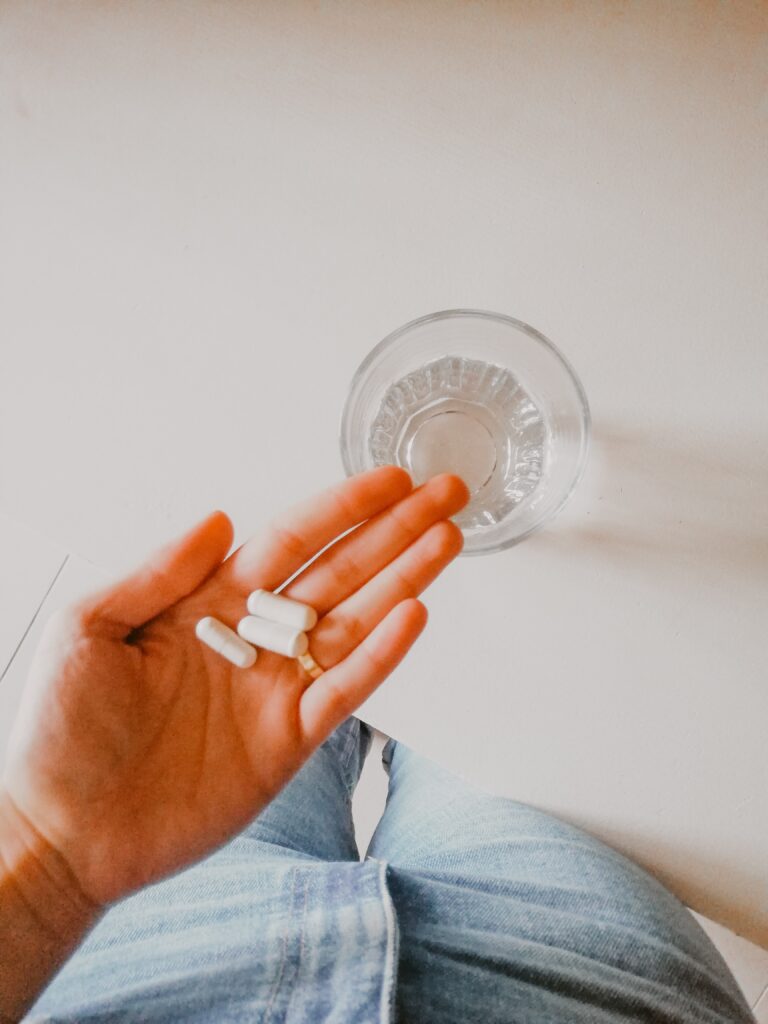- Prebiotics are different types of fiber that support the growth of your microbiome, including both gut flora and vaginal flora.
- There are two main groups of prebiotics. The first is the non-digestible fibrous kind in fruits and vegetables. The second is the bacteriophage prebiotic, which works by actively seeking our bad bacteria and eliminating them from the body.
- Probiotics don’t just balance the microorganisms in your gut—they balance those found in your vagina, skin, and other areas too!
You’ve probably heard of probiotics before—they’re live microorganisms found naturally in your body as well as in foods like yogurt, kombucha, and kimchi, and they’re hugely beneficial for your gut and vaginal health.
Chances are, you haven’t heard of their lesser-known counterpart, prebiotics.
If you’ve ever heard someone mention dandelion greens in a conversation, you’ve probably been around someone who knows a little about prebiotics. They’re kind of a hot topic these days—you might even have products labeled as “containing probiotics and prebiotics” in your local health food store.
What exactly are prebiotics, and do they have anything to do with probiotics?
In short, prebiotics are different types of fiber that support the growth of your microbiome, including both gut flora and vaginal flora. Prebiotics occur naturally in the environment; in fact, prebiotics are glucose, so fruits, vegetables, legumes, and grains contain them. Prebiotics can also be living organisms, called bacteriophages. Prebiotic bacteriophages are small organisms that can help support the growth of certain types of bacteria.
A healthy microbiome sounds like a good thing, right? It is, and the right combination of prebiotic and probiotic supplements can help you get there. To help you get started on your inner wellness journey, keep reading to learn everything you need to know about prebiotics and their role in the diets of healthy adults.
What are Prebiotics?
Prebiotics are derived from the sugar sources in fiber. They are indigestible and serve as an energy source for probiotic bacteria—the friendly bacteria in the small and large intestine.
There are two main groups of prebiotics. The first is the non-digestible fibrous kind in fruits and vegetables. The second is the bacteriophage prebiotic, which works by actively seeking our bad bacteria and eliminating them from the body. Both kinds of prebiotics can be found in prebiotic supplements.
Two of the most promising prebiotics on the market today are PreforPro and Uclear D-Mannose. Both can be helpful for the treatment of bacterial vaginosis (BV) and urinary tract infections (UTIs) when combined with probiotics, which you can consume either from supplements or from probiotic foods.
Prebiotics and probiotics might sound alike, but they’re very different in terms of nature and function. However, they both have an important role in human health, and together they work hand in hand to support healthy gut bacteria and keep your digestive system happy.
What’s the Difference Between Prebiotics and Probiotics?
| Prebiotics | Probiotics | |
| Definitions | An ingredient that helps in the proliferation of probiotics. | The friendly bacteria that benefit your body’s digestive, immune, and sexual health. |
| Major groups/types | The two major groups of beneficial prebiotics are starch/fiber-based and bacteriophages. | The most commonly studied species of probiotics are Lactobacillus, Bifidobacterium, and Bacilus Coagulans. |
| Common sources | Prebiotics come from plant fibers. Some of the best prebiotic sources are leeks, chicory roots, Konjac root, Jerusalem artichokes, bananas, and whole grains like oats, barley, and flax seeds. Prebiotic supplements also exist. | Common sources of probiotics are fermented foods (also known as probiotic foods), like kefir, sauerkraut, kimchi, yogurt, and kombucha. Probiotic supplements are also available. |
| Health benefits(Probiotics and prebiotics work in synergy) | Fibrous prebiotics serve as an energy source for probiotic microorganisms. This means that they help maintain your intestinal microflora. (1) They can also aid in maintaining vaginal pH and removing bacteria from the urinary tract. Bacteriophage prebiotics work by targeting bad bacteria and eliminating them from the microbiome. | Research has shown that probiotics have beneficial effects on gut health, metabolic health, and vaginal health. (2) They also help in reducing blood pressure and blood cholesterol levels. |
Why Do They Call it Prebiotic Fiber?
Prebiotics essentially amplify the effectiveness of probiotics. They do this by acting as a food source for the live microorganisms in your gut (which are also known as gut flora). In order to be considered a prebiotic fiber, they need to pass the following three criteria:
- They should not be digested by the enzymes and acid in your stomach and small intestine.
- They should promote and maintain the growth of healthy gut microflora.
- They should be fermented in the large intestine by beneficial bacteria. (3)
What are the Benefits of Prebiotics?
Generally, the more fruits, vegetables, and whole grains you have on your plate, the better: аll of these foods are very beneficial for your overall health. Research has shown that prebiotics provide lots of additional health benefits, including the following:
- Different types of beneficial yeasts and good bacteria in your digestive tract feed on prebiotics and ferment them. Therefore, prebiotics can regulate the composition and amount of beneficial bacteria (probiotics) in your gut. (4)
- Prebiotics can also support digestive health by strengthening the intestinal walls and producing nutrients for it, such as short-chain fatty acids. (5)
- Human studies have shown that the combination of prebiotics with probiotics plus the byproducts of prebiotic fermentation reduce colon cancer risk. (6)
- Prebiotics might also boost immune health. That’s because they feed healthy bacteria, which causes them to increase in number and more effectively fight harmful bacteria. They also stimulate the production of immune cells, such as cytokines. Clinical trials have shown that taking prebiotic courses might improve the response to vaccines. (7)
- A small amount of prebiotics (about 5 grams of prebiotics) have shown positive effects on mood regulation in one study with 30-year-old individuals. (8) They also improved the participants’ short-term memory.
- Prebiotics of the galacto-oligosaccharide (GOS) type also support skin health and reduce the risk of inflammatory skin diseases, such as atopic dermatitis. (9) The mixture of GOS with or without probiotics has been shown to increase water retention and enhance the skin’s natural barrier capacities.
- Prebiotics have been linked with improved absorption of minerals such as calcium in postmenopausal women. (10) Therefore, they might have a protective effect against osteoporosis and other bone diseases.
Additionally, prebiotics (and other foods with a high fiber content) play a role in weight loss—in combination with a daily health routine including a nutrient-rich diet, of course.

What are Some Common Examples of Foods Containing Prebiotics?
Many different types of fruit and vegetables contain prebiotics. Legumes (peas, lentils) and whole grains are also a good source of prebiotics. Some of the best prebiotic foods are:
- Chicory root
- Dandelion greens
- Garlic
- Onion
- Leeks
- Asparagus
- Jerusalem artichoke
- Bananas
- Apples
- Barley
- Konjac root
- Oats
- Tomatoes
- Chickpeas
- Lentils

Chicory root, which is commonly used as an alternative to coffee, contains 65% fiber. It has GOS and inulin, which might help improve metabolic and digestive health, aid in the digestion of fats, and relieve constipation by promoting regular bowel movements. (11)
Garlic contains 17% prebiotics (inulin and fructooligosaccharides [FOS]). (12) The high content of FOS prebiotics in garlic extracts stimulates the growth of Lactobacillus acidophilus, a type of beneficial gut bacteria, by 4%.
Just like garlic, leeks are also rich in prebiotics, mainly in the form of inulin. (13) Leeks also contain high amounts of vitamin K and flavonoids. They might improve the growth of good bacteria, support bone health, and improve muscle health.
The combination of antioxidants, prebiotic fibers (inulin), and other compounds in asparagus might reduce the risk of cancer and inflammation. (14) It also improves overall digestive health. Asparagus contains 2–3 grams of fiber per 100 grams.
Artichokes are another great source of prebiotics and contain a similar fiber content to asparagus (2 grams/100 grams). They enhance gut and overall health by promoting good bacteria’s growth and strengthening the immune system.
Whole grains such as oats, barley, and wheat are very rich in prebiotic fibers. The fiber they contain is usually 70–80% prebiotic. Whole grain prebiotic fibers have shown to have positive effects on overall health, such as:
- Lowering blood cholesterol and blood sugar levels
- Improving heart and digestive health
- Reducing the risk of cancer (15)
Can You Take Prebiotics and Probiotics Together?
Generally, taking prebiotics and probiotics together is not very effective. There are two very simple reasons why.
The first is that prebiotics must be consumed in large quantities for them to work. The average supplement capsule or tablet contains between 600–800 milligrams of raw prebiotic material (and this is assuming that it’s an easy material for probiotics to use). For most prebiotics, you must consume a daily dose of nearly 5 grams per day to get the benefits, which is the equivalent of 7–9 capsules!

The second issue has to do with the makeup of the prebiotics and the activity of water. A typical starch- or glucose-based prebiotic contains water. Probiotics, however, degrade when water is present.
With all this in mind, you might be wondering the best way to combine prebiotics and probiotics, and whether prebiotic supplements actually work. There are two prebiotic supplements currently on the market that work well.
PreforPro: PreforPro is a prebiotic bacteriophage. It is neither glucose- nor starch-based and has no water activity whatsoever. It works by actually attacking harmful bacterial species so that beneficial bacteria can proliferate.
The balance between beneficial and harmful bacteria is crucial—and both compete for the prebiotics you consume.
The role of the bacteriophages found in PreforPro is to eliminate bad bacteria. This, in turn, gives probiotics the chance to feed on the prebiotics you consume with food and with supplements.
Preforpro works through the lyctic cycle. The bacteriophage finds a host and injects its own DNA into it, causing new bacteriophages to spawn destroying th bad pathogen from within. Once the Bacteriophage has destroyed all the bad bacteria like E. Coli, it exits the body via fecal matter.

D-mannose: D-mannose is a prebiotic that attaches to E. Coli receptors so that it cannot attach to the urinary tract; this mechanis, of action inhibits infections from starting in the first palce.
You can read more about how D-mannose works in our D-mannose guide.
When is the Best Time to Take Prebiotics?
You can take prebiotics whenever it suits you—as long as you don’t forget them. Try them with food or before your first meal to help you remember.
What is the Best Prebiotic and Probiotic?
There are a few criteria to keep in mind when choosing a prebiotic and a probiotic. Opt for a formula that:
- Follows the scientific recommendations
- Contains amounts that correspond to the clinically studied dosages
- Doesn’t degrade
A Healthy Body Starts With a Healthy Gut
Probiotics don’t just balance the microorganisms in your gut—they balance those found in your vagina, skin, and other areas too! Happy V has designed a unique prebiotics + probiotic supplement for vaginal health containing ingredients proven to be beneficial in clinical studies at their clinically proven dosages. This means that in addition to the other prebiotic effects mentioned above, our supplement can:
- Improve your vaginal health
- Balance the vaginal pH
- Increase the concentration of good bacteria in your vagina
- Reduce bloating
- Restore digestive health
- Improve urinary health

D-Mannose + Cranberry
Our Happy V® D-Mannose + Cranberry was created for anyone who is experiencing symptoms related to Urinary Tract Infections. Eliminate the pain, burning sensation, constant need to urinate and vaginal irritation.
Learn moreIf you’re suffering from UTIs or other urinary health issues, Happy V has supplements to help. Cranberry Urinary Defense by Happy V contains cranberry extracts, which are proven to help treat and manage UTIs’ symptoms. Your gut health greatly impacts your vaginal health. Support a healthy microbiome with prebiotic and probiotic supplements. Your body will thank you!
- https://pubmed.ncbi.nlm.nih.gov/29976412/
- https://www.mdpi.com/2304-8158/8/3/92
- https://europepmc.org/article/med/7782892
- https://europepmc.org/article/med/7782892
- https://journals.asm.org/doi/10.1128/AEM.71.7.3692-3700.2005
- https://pubmed.ncbi.nlm.nih.gov/20874522/
- https://www.ncbi.nlm.nih.gov/pmc/articles/PMC5037510/
- https://pubmed.ncbi.nlm.nih.gov/26516908/
- https://www.ncbi.nlm.nih.gov/pmc/articles/PMC2066015/
- https://academic.oup.com/ajcn/article/83/2/310/4649990?login=true
- https://www.cambridge.org/core/journals/british-journal-of-nutrition/article/jerusalem-artichoke-and-
- https://pubmed.ncbi.nlm.nih.gov/32095058/
- https://nutritiondata.self.com/facts/vegetables-and-vegetable-products/2470/2
- https://pubmed.ncbi.nlm.nih.gov/24310501/
- https://pubmed.ncbi.nlm.nih.gov/26092171/
Check out Our Prebiotic + Probiotic to cover all your women wellness needs!
- A-
- A+
Check out Our Prebiotic + Probiotic to cover all your women wellness needs!





